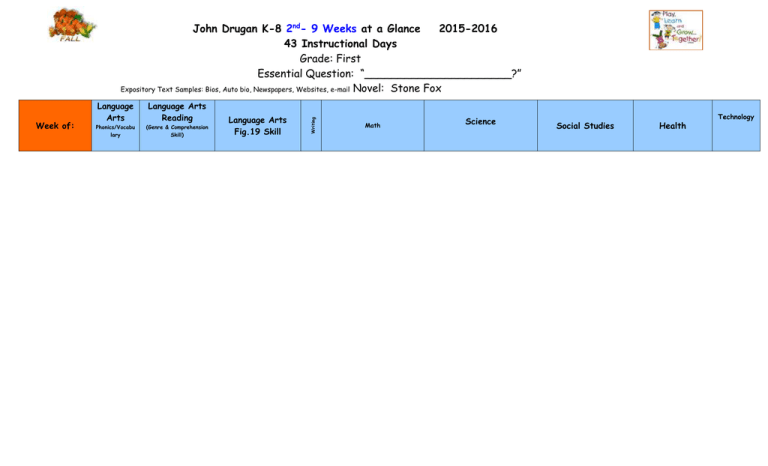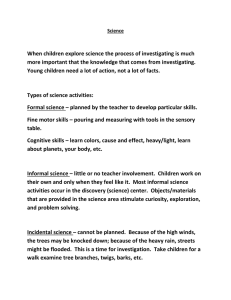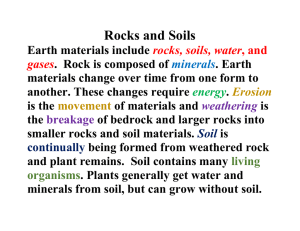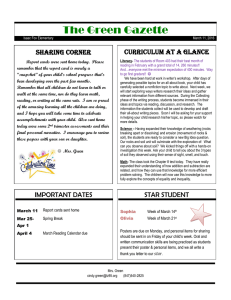John Drugan K-8 at a Glance 2015-2016 2
advertisement

Week of: Language Arts Language Arts Reading Phonics/Vocabu lary (Genre & Comprehension Skill) Language Arts Fig.19 Skill Writing John Drugan K-8 2nd- 9 Weeks at a Glance 2015-2016 43 Instructional Days Grade: First Essential Question: “______________________?” Expository Text Samples: Bios, Auto bio, Newspapers, Websites, e-mail Novel: Stone Fox Math Science Social Studies Health Technology 1.Fig. 19A- Establish Informational Text Newspaper 1.10- ID the features of nonfiction Week 1 Oct. 12-16 Word Play Lesson 3638 Assessment 1.10A- Determine whether a story is true or a fantasy and explain why. purposes for reading selected texts based upon desired outcome to enhance comprehension. (to be informed, be entertained, to enjoy language, become involved in real/imagined events/setting/actions) See Writing Plan Treasures Unit 2 Wk. 2 Unit 6: Developing Sums and Minuends to 10 1.2A,1.3A, 1.3B(T), 1.3E, 1.3F,1.5D 1.5 E, 1.5F(T) , 1.5G(T) , 1.3C, 1.3D(T) Process Standards: 1.1A, 1.1B,1.1C,1.1D,1.1E, 1.1F,1.1G 1.2(A) recognize instantly the quantity of structured arrangements SS 1.3(A) use concrete and pictorial models to determine the sum of a multiple of ten and a one‐digit number in problems up to 99 SS 1.3(B) use objects and pictorial models to solve word problems involving joining, separating, and comparing sets within 20 and unknowns as any one of the terms in the problem such as 2+4=___; 3+___=7; and 5 = ____‐3 SS 84%, 68%, 87% 1.3(C) compose 10 with two or more addends with and without concrete objects SS Investigating Force, Motion, and Energy Unit 4: Thinking Like a Geographer Unit 03: Investigating Force, Motion, and Energy 1.4A locate places using the four cardinal directions 1.1A; 1.2CDE; 1.4A; 1.6ABCD 1.4B describe the location of self and objects relative to other locations in the classroom and school *1.6A- identify/discuss how different forms of energy are important to everyday life (light-sunlight/artificial light, heatSun/fire/seasons/appliances, soundsafety) 1.3C- Ben Franklin & Thomas Edison- inventor of the light Bulb *1.6B- predict/describe how magnet can be used to push /pull -attract object (attract- between 2 magnets/ between a magnet & magnetic material; repelling- between 2 magnets) 1.6C- describe change in location of object (closer to, nearer to, farther from) 1.6D- demonstrate/record ways objects can move (straight line, zig/zag, up/down, fast/slow, back/forth, round/round, back & forth) 1.5A create and use simple maps such as maps of the home, classroom, school, and community 1.5B locate the community, Texas, and the US on maps and globes *1.6A identify and describe the physical characteristics of place: Landforms, bodies of water, natural resources, and weather *1.6B identify examples of and uses for natural resources in the community, state, and nation *1.6C identify and describe how the human characteristics of place such as shelter, clothing, food, and activities are based upon geographic location 1.2A- identify and use protective equipment to prevent injury 1.6Cperform basic software application functions, including opening an application and creating, modifying, printing, and saving files Treasures Unit 2 Wk. 3 Informational Text Magazine Week 2 Oct. 19-23 1.13A- Identify the topic and explain the author’s purpose in writing about the text (to tell about, to explain, to tell how to do something) Word Play Lesson 3940 *1.14A- Restate the main idea, heard or read Readiness Standard 1.4C- Establish purpose for reading selected texts (to be informed, to follow directions, to be entertained) Unit 6: Developing Sums and Minuends to 10 1.2A,1.3A, 1.3B(T), 1.3E, 1.3F,1.5D 1.5 E, 1.5F(T) , 1.5G(T) , 1.3C, 1.3D(T) Process Standards: 1.1A, 1.1B,1.1C,1.1D,1.1E, 1.1F,1.1G 1.3(D) apply basic fact strategies to add and subtract within 20, including making 10 and decomposing a number leading to a 10 SS 69%, 87%, 60% 1.3(E) explain strategies used to solve addition and subtraction problems up to 20 using spoken words, objects, pictorial models, and number sentences SS 1.3(F)* generate and solve problem situations when given a number sentence involving addition or subtraction of numbers within 2 RS Investigating Force, Motion, and Energy Unit 4: Thinking Like a Geographer Unit 03: Investigating Force, Motion, and Energy (11 days) 1.4A locate places using the four cardinal directions 1.1A; 1.2CDE; 1.4A; 1.6ABCD 1.4B describe the location of self and objects relative to other locations in the classroom and school *1.6A- identify/discuss how different forms of energy are important to everyday life (light-sunlight/artificial light, heatSun/fire/seasons/appliances, soundsafety) 1.3C- Ben Franklin & Thomas Edison- inventor of the light Bulb *1.6B- predict/describe how magnet can be used to push /pull -attract object (attract- between 2 magnets/ between a magnet & magnetic material; repelling- between 2 magnets) 1.6C- describe change in location of object (closer to, nearer to, farther from) 1.6D- demonstrate/record ways objects can move (straight line, zig/zag, up/down, fast/slow, back/forth, round/round, back & forth) 1.5A create and use simple maps such as maps of the home, classroom, school, and community 1.5B locate the community, Texas, and the US on maps and globes *1.6A identify and describe the physical characteristics of place: Landforms, bodies of water, natural resources, and weather *1.6B identify examples of and uses for natural resources in the community, state, and nation *1.6C identify and describe how the human characteristics of place such as shelter, clothing, food, and activities are based upon geographic location 1.2A- identify and use protective equipment to prevent injury 1.6Cperform basic software application functions, including opening an application and creating, modifying, printing, and saving files Week 3 Oct. 26-30 Early Release Treasures Unit 2 Wk. 4 Word Play Lesson 4142 Informational Text E-mail articles *1.14B- Identify important facts or details in text, heard or read (fact/details that support the main idea by telling how, when, what, where, why, how much, how many focus on one paragraph or short selection) Readiness Standard *1.14C-Retell the order of events in a text by referring to the words and/or illustrations (first, next, second, third, after) Readiness Standard 1.Fig. 19B- Ask literal questions of text. (?Before/?After/?During reading; Literal ?-who, what, when, where, why, & how) Unit 6: Developing Sums and Minuends to 10 1.2A,1.3A, 1.3B(T), 1.3E, 1.3F,1.5D 1.5 E, 1.5F(T) , 1.5G(T) , 1.3C, 1.3D(T) Process Standards: 1.1A, 1.1B,1.1C,1.1D,1.1E, 1.1F,1.1G 1.5(D) represent word problems involving addition and subtraction of whole numbers up to 20 using concrete and pictorial models and number sentences RS 1.5(E) understand that the equal sign represents a relationship where expressions on each side of the equal sign represent the same value(s) SS Investigating the Natural World: Rocks, Soil, and Water Unit 04: Investigating the Natural World: Rocks, Soil, and Water (15 days) 1.1A; 1.2ABCDE; 1.4A; 1.7ABC *1.7A- Observe, compare, describe, sort components of soil (size- very small (clay), medium (loamy soil), large (sand), texture- rough, smooth, sticky, color (gray, black, brown, rust, tan, beige), components-air, water, organic material, minerals) 1.7B- Identify/describe natural resources of water (streams, lakes, oceans, pond, river, glacier) 1.7C- gather evidence of how rocks, soil, water help to make useful products (building, making jewelry, recycling, collecting rain water) 1.3C- Florence Bascom (geologist) Unit 4: Thinking Like a Geographer 1.4A locate places using the four cardinal directions 1.4B describe the location of self and objects relative to other locations in the classroom and school 1.5A create and use simple maps such as maps of the home, classroom, school, and community 1.5B locate the community, Texas, and the US on maps and globes *1.6A identify and describe the physical characteristics of place: Landforms, bodies of water, natural resources, and weather *1.6B identify examples of and uses for natural resources in the community, state, and nation *1.6C identify and describe how the human characteristics of place such as shelter, clothing, food, and activities are based upon geographic location Red Ribbon Week 1.2C- explain the harmful effects of, and how to avoid, alcohol, tobacco, and other drugs 1.1Ccreate original products using a variety of resources 1.1Dcreate and execute steps to accomplish a task 1.2Cformat digital information, including font attributes, color, white space, graphics, and animation, for a defined audience & communicati on medium Treasures Unit 2 Wk. 5 Informational Text science, social studies text Week 4 Nov. 2-6 *1.14D- Use text features (title, table of contents, illustrations, bold/italicized text, charts & graphs) to locate specific information in text. Readiness Standard Word Play Lesson 4344 *1.4B- Ask relevant questions, seek clarification, and locate facts and details about stories and other texts. (Literal ?- who is main character, setting, topic? focus on one paragraph at a time) Unit 6: Developing Sums and Minuends to 10 1.2A,1.3A, 1.3B(T), 1.3E, 1.3F,1.5D 1.5 E, 1.5F(T) , 1.5G(T) , 1.3C, 1.3D(T) Process Standards: 1.1A, 1.1B,1.1C,1.1D,1.1E, 1.1F,1.1G 1.5(F) determine the unknown whole number in an addition or subtraction equation when the unknown may be any one of the three or four terms in the equation SS 39%, 14%, 59% 1.5(G)* apply properties of operations to add and subtract two or three numbers RS 39%, 30%, 88% Investigating the Natural World: Rocks, Soil, and Water Unit 4: Thinking Like a Geographer Unit 04: Investigating the Natural World: Rocks, Soil, and Water (15 days) 1.4A locate places using the four cardinal directions 1.1A; 1.2ABCDE; 1.4A; 1.7ABC *1.7A- Observe, compare, describe, sort components of soil (size- very small (clay), medium (loamy soil), large (sand), texture- rough, smooth, sticky, color (gray, black, brown, rust, tan, beige), components-air, water, organic material, minerals) 1.7B- Identify/describe natural resources of water (streams, lakes, oceans, pond, river, glacier) 1.7C- gather evidence of how rocks, soil, water help to make useful products (building, making jewelry, recycling, collecting rain water) 1.3C- Florence Bascom (geologist) 1.4B describe the location of self and objects relative to other locations in the classroom and school 1.5A create and use simple maps such as maps of the home, classroom, school, and community 1.5B locate the community, Texas, and the US on maps and globes *1.6A identify and describe the physical characteristics of place: Landforms, bodies of water, natural resources, and weather *1.6B identify examples of and uses for natural resources in the community, state, and nation *1.6C identify and describe how the human characteristics of place such as shelter, clothing, food, and activities are based upon geographic location 1.2C- explain the harmful effects of, and how to avoid, alcohol, tobacco, and other drugs 1.1Ccreate original products using a variety of resources 1.1Dcreate and execute steps to accomplish a task 1.2Cformat digital information, including font attributes, color, white space, graphics, and animation, for a defined audience & communicati on medium Treasures Unit 3 Wk. 1 Week 5 Nov. 9-13 Veteran’s Day Nov. 11 No School Word Play Lesson 4445 Procedural Text Recipe/Game 1.15A- Follow written multi-step directions with picture cues to assist with understanding (Text that Explain How Something Works-instructions, directions, manuals; Text that Tell How To Do an Activity-recipe, game, rules, scientific method) 1.15B- Explain the meanings of specific signs & symbols (map features, STOP sign, traffic lights, EXIT, poison symbols, warning signs, Symbols that represent something else-+, $, #, &). 1.Fig. 19C- Monitor and adjust comprehension (using background knowledge, creating sensory images, rereading a portion aloud). Unit 7: Number Patterns 1.5 A, 1.5B, Process Standards: 1.1C,1.1D 1.5(A) recite numbers forward and backward from any given number between 1 and 120 SS 1.5(B)* skip count by twos, fives, and tens to determine the total number of objects up to 120 in a set SS Investigating the Natural World: Rocks, Soil, and Water Unit 04: Investigating the Natural World: Rocks, Soil, and Water (15 days) 1.1A; 1.2ABCDE; 1.4A; 1.7ABC *1.7A- Observe, compare, describe, sort components of soil (size- very small (clay), medium (loamy soil), large (sand), texture- rough, smooth, sticky, color (gray, black, brown, rust, tan, beige), components-air, water, organic material, minerals) 1.7B- Identify/describe natural resources of water (streams, lakes, oceans, pond, river, glacier) 1.7C- gather evidence of how rocks, soil, water help to make useful products (building, making jewelry, recycling, collecting rain water) 1.3C- Florence Bascom (geologist) Unit 5: Celebrating Our Community 1.1A describe the origins of customs, holidays, and celebrations of the community, state, and nation: San Jacinto Day, Independence Day, and Veterans Day 1.1B compare the observance of holidays and celebrations, past and present. *1.15A describe and explain the importance of various beliefs, customs, language, and traditions of families and communities 1.15B explain the way folktales and legends: Aesop's fables reflect beliefs, customs, language, and traditions of communities. 1.2D- identify ways to avoid weapons and drugs or harming oneself or another person by staying away from dangerous situations and reporting to an adult 1.1Ccreate original products using a variety of resources 1.1Dcreate and execute steps to accomplish a task 1.2Cformat digital information, including font attributes, color, white space, graphics, and animation, for a defined audience & communicati on medium Procedural Text Week 6 Nov. 16-20 Treasures Unit 3 Wk. 2 Word Play Lesson 45-46 How to make a Craft/ 1.15A- Follow written multi-step directions with picture cues to assist with understanding (Text that Explain How Something Works-instructions, directions, manuals; Text that Tell How To Do an Activity-recipe, game, rules, scientific method) 1.4C- monitor comprehension, making corrections and adjustments when that understanding breaks down (identifying clues, using background knowledge, generating questions, re-reading a portion aloud, create sensory images, ask for help) Unit 8: Attributes of Coins 1.4A, 1.4B, 1.4C(T) Process Standards: 1.1A, 1.1D 1.4(A)* identify U.S. coins including pennies, nickels, dimes and quarters by value and describe the relationships between them SS 94% 1.4(B) write a number with the cent symbol to describe the value of a coin SS 1.4(C)* use relationships to count by twos, fives, and tens to determine the value of a collection of pennies, nickels and/or dimes RS 26%, 45%, 78% Investigating Natural Resources Through Conservation Unit 5: Celebrating Our Community Unit 05: Investigating Natural Resources Through Conservation (8 days) 1.1A describe the origins of customs, holidays, and celebrations of the community, state, and nation: San Jacinto Day, Independence Day, and Veterans Day 1.1C; 1.3A; 1.4A; 1.7C 1.1C- identify/learn how to use natural resources/materials (conservation, reuse/recycle of paper, plastic, metals) 1.1B compare the observance of holidays and celebrations, past and present. *1.15A describe and explain the importance of various beliefs, customs, language, and traditions of families and communities 1.15B explain the way folktales and legends: Aesop's fables reflect beliefs, customs, language, and traditions of communities. 1.2D- identify ways to avoid weapons and drugs or harming oneself or another person by staying away from dangerous situations and reporting to an adult 1.1C- create original products using a variety of resources 1.1D- create and execute steps to accomplish a task 1.2C- format digital information, including font attributes, color, white space, graphics, and animation, for a defined audience & communicatio n medium Treasures Unit 3 Wk.3 Week 7 Nov. 30-Dec 4 Signs and Symbols Word Play Lesson 4748 1.15B- Explain the meanings of specific signs & symbols (map features, STOP sign, traffic lights, EXIT, poison symbols, warning signs, Symbols that represent something else-+, $, #, &). *1.Fig.19D- Make inferences about text & use textual evidence to support Understanding (title, cover, illustrations, plot, facts/details, background knowledge) Readiness Standard 1.4A- Confirm predictions about what will happen next in text by “reading the part that tells.” (stopping regularly to summarize what is being read, check & revise predictionsfocus on one paragraph or entire text Unit 8: Attributes of Coins 1.4A, 1.4B, 1.4C(T) Process Standards: 1.1A, 1.1D 1.4(A)* identify U.S. coins including pennies, nickels, dimes and quarters by value and describe the relationships between them SS 94% 1.4(B) write a number with the cent symbol to describe the value of a coin SS 1.4(C)* use relationships to count by twos, fives, and tens to determine the value of a collection of pennies, nickels and/or dimes RS 26%, 45%, 78% Investigating Natural Resources Through Conservation Unit 5: Celebrating Our Community Unit 05: Investigating Natural Resources Through Conservation (8 days) 1.1A describe the origins of customs, holidays, and celebrations of the community, state, and nation: San Jacinto Day, Independence Day, and Veterans Day 1.1C; 1.3A; 1.4A; 1.7C 1.1C- identify/learn how to use natural resources/materials (conservation, reuse/recycle of paper, plastic, metals) 1.1B compare the observance of holidays and celebrations, past and present. *1.15A describe and explain the importance of various beliefs, customs, language, and traditions of families and communities 1.15B explain the way folktales and legends: Aesop's fables reflect beliefs, customs, language, and traditions of communities. 1.2E- identify safety rules that help to prevent poisoning 1.6C- perform basic software application functions, including opening an application and creating, modifying, printing, and saving files Comprehensive Assessment Fiction Week 8 Dec. 7-11 Mike Finn, Kasey Johns, Johnny Appleseed, John Henry Word Play Lesson 4950 Fantasy, Realistic Fiction, Fables, Myths, Legends, Historical Fiction)(Mike Finke, Casey Jones, Johnny Appleseed, John Henry, ) *1.9A- Describe the plot (problem and solution) and retell a story’s beginning, middle, and end with attention to the sequence of events Readiness St. 1.Fig. 19E- Retell or act out important events in stories in logical order (draw a picture, present dramatic interpretation, orally retell order of events) Readiness Standard *1.Fig. 19F- Make connections to own experiences, to ideas in other texts, and to the larger community, and discuss textual evidence (own experiences, ideas in other text, larger community) *1.9B- Describe characters in a story and the reasons for their actions and feelings (physical traits, emotional traits, personal traits, characters actions) Readiness Standard Week 9 Dec. 14-18 (5 days) Early Release Dec. 18 Review Technology Projects: Take Home Project: Review Review Author’s Wall Post Treasures Unit 3 Wk. 4 Unit 9: Numeration 50-80 1.2B,1.2C(T),1.2D,1.2E(T) Process Standards: 1.1C, 1.1D, 1.1E 1.2(B)* use concrete and pictorial models to compose and decompose numbers up to 120 in more than one way as so many hundreds, so many tens, and so many ones SS 1.2(D) generate a number that is greater than or less than a given whole number up to 120 SS 1.2(E) use place value to compare whole numbers up to 120 using comparative language SS 1.2(C)* use objects, pictures, and expanded and standard forms to represent numbers up to 120 RS Investigating Objects in the Sky Unit 07: Investigating Objects in the Sky (10 days) 1.2D; 1.3B; 1.4A; 1.8BC *1.8B- observe/record changes in appearance of objects in sky (clouds, 1.8C- Identify characteristics of day & night Unit 5: Celebrating Our Community 1.1A describe the origins of customs, holidays, and celebrations of the community, state, and nation: San Jacinto Day, Independence Day, and Veterans Day 1.2F- identify and describe safe bicycle skills 1.4Cevaluate products prior to final submission Review Review 1.1B compare the observance of holidays and celebrations, past and present. *1.15A describe and explain the importance of various beliefs, customs, language, and traditions of families and communities 1.15B explain the way folktales and legends: Aesop's fables reflect beliefs, customs, language, and traditions of communities. (NEW) Personal Financial Literacy(5 days) 1.9 A 1.9 B , 1.9 C (T) 1.9 D Process Standards: 1.1 A, 1.1 E, 1.1 F, 1.1 C 1.9(A) define money earned as income SS 84% 1.9(B) identify income as a means of obtaining goods and services, often times making choice between wants and needs SS 1.9(C) distinguish between spending and saving SS 87%, 84%, 90% 1.9(D) consider charitable giving SS Investigating Objects in the Sky Unit 07: Investigating Objects in the Sky (10 days) 1.2D; 1.3B; 1.4A; 1.8BC *1.8B- observe/record changes in appearance of objects in sky (clouds, Moon, stars Sun) 1.8C- Identify characteristics of day & night Review



